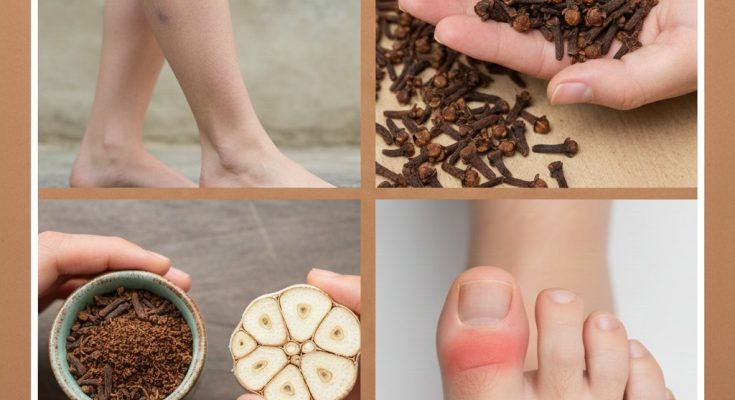That familiar throb in your knees after a long day, the heaviness in your calves that makes every step feel like wading through mud, the restless nights when joint stiffness wakes you before dawn – if you’re nodding along, you’re far from alone. Millions quietly battle leg pain, arthritis discomfort, and poor circulation that steals their mobility and joy. It creeps up slowly, turning simple walks or standing in the kitchen into dreaded chores, leaving you exhausted and frustrated. But here’s the thing: many have found soothing comfort from something sitting right in your pantry – and later, I’ll share a traditional garlic method that’s surprised even skeptical doctors with how gently yet effectively it supports aching joints and tired legs.

What Makes Garlic a Time-Tested Ally for Sore Joints and Legs?
Garlic isn’t just for flavor – it’s been cherished across cultures for centuries as a natural supporter of joint health and blood flow.
The star compound? Allicin. When you crush or chop fresh garlic, this sulfur-rich powerhouse forms almost instantly. Research suggests allicin contributes to garlic’s ability to ease inflammation gently, which is why traditional remedies often rely on raw or lightly prepared garlic.
But that’s not all…
Studies, including randomized trials published on PubMed, have explored how garlic supplementation may help reduce stiffness in knee joints and support overall comfort in people dealing with osteoarthritis or rheumatoid arthritis. One review even noted garlic’s role in traditional medicine for soothing arthritis symptoms dating back thousands of years.
And for circulation? Garlic has a long reputation for promoting healthy blood flow – something especially helpful when poor circulation leads to that heavy, achy feeling in the legs.
The Science Behind Garlic’s Soothing Effects (Without the Hype)
Let’s keep it real – garlic won’t magically erase years of wear and tear, but evidence points to meaningful support:
- Anti-inflammatory action: Multiple clinical studies show compounds in garlic can lower markers of inflammation, similar to how some over-the-counter options work – but naturally.
- Circulation boost: Garlic helps blood vessels relax, encouraging smoother flow. This is why many notice warmer feet and less leg fatigue.
- Antioxidant protection: Free radicals worsen joint discomfort; garlic’s antioxidants help neutralize them.
Here’s a quick comparison of how garlic stacks up in traditional vs. modern use:
| Aspect | Traditional View | What Research Suggests |
|---|---|---|
| Joint Stiffness | Warm wraps ease morning rigidity | May reduce stiffness scores in OA trials |
| Leg Heaviness | Improves “cold” legs overnight | Supports healthy blood flow and vessel relaxation |
| Everyday Comfort | Daily raw clove for ongoing relief | 8–12 week supplementation linked to better mobility |
The truth is… most people try garlic because a relative swore by it – and end up pleasantly surprised when science backs the family lore.

The Traditional Garlic Leg Wrap Your Grandmother Probably Knew
This simple topical remedy has been passed down in Mediterranean and Asian households for generations. It’s gentle, costs pennies, and many report noticeable soothing after just a few nights.
Why a wrap (not just eating garlic)?
Direct contact lets the beneficial compounds absorb where you need them most – knees, ankles, calves – while the mild warmth boosts circulation.
Step-by-Step: The Soothing Garlic Poultice Wrap
You’ll need:
- 6–8 fresh garlic cloves
- Clean cotton cloth or cheesecloth
- Mild carrier oil (olive or coconut)
- Plastic wrap and a warm towel
- Peel and finely crush the garlic (let it sit 10 minutes – this maximizes allicin).
- Mix the crushed garlic with 2–3 tablespoons of oil to form a paste.
- Spread the paste thinly on the cloth (avoid direct skin if sensitive – test a small area first).
- Apply to clean, dry legs/knees, cover loosely with plastic wrap, then wrap with a warm towel.
- Relax for 20–40 minutes (many do this before bed).
- Rinse gently with warm water.
Use 3–5 nights a week. Most notice legs feel lighter and joints less stiff by morning.
Pro tip: Combine with eating 1 raw clove daily (chopped into honey if the taste is strong) for inside-out support.
Other Easy Ways to Add Garlic Comfort Daily
- Morning ritual: Chop 1 clove, let sit 10 min, swallow with water or honey.
- Garlic tea: Simmer sliced garlic in hot water with lemon – soothing and circulation-friendly.
- Infused oil massage: Warm garlic oil and gently rub into sore spots.
Quick Daily Garlic Habits
| Time of Day | Method | Potential Benefit |
|---|---|---|
| Morning | Raw clove in honey | Kickstarts circulation |
| Evening | Poultice wrap | Overnight joint soothing |
| With meals | Roasted or fresh in food | Gentle ongoing support |
Real Stories from Real People
“I was skeptical, but after two weeks of the wrap, my knees didn’t ache climbing stairs anymore.” – Maria, 68
“My circulation was so poor my feet were always ice-cold. Garlic changed that.” – John, 72
These aren’t miracles – just consistent, gentle support many wish they’d tried sooner.

Conclusion: Small Kitchen Habit, Big Comfort Difference
Leg pain, arthritis stiffness, and poor circulation don’t have to dictate your days. This humble bulb has comforted generations – and modern research is catching up to why. Start small tonight with the wrap or a single clove, listen to your body, and you may just rediscover the joy of moving freely.
FAQ
1. Is raw garlic safe every day?
Most adults tolerate 1–2 cloves fine. Start slow to avoid digestive upset.
2. Can I use garlic if I’m on blood thinners?
Garlic may enhance blood-thinning effects – always check with your doctor first.
3. How long until I notice comfort?
Many feel lighter legs within a week; consistent use over 4–8 weeks often brings the best support.
Important Disclaimer: This article is for informational purposes only and not medical advice. Garlic is a traditional remedy that may support comfort for leg pain, arthritis symptoms, and circulation, but it is not a cure or treatment for any disease. Always consult your healthcare provider before trying new remedies, especially if you have health conditions or take medications.



